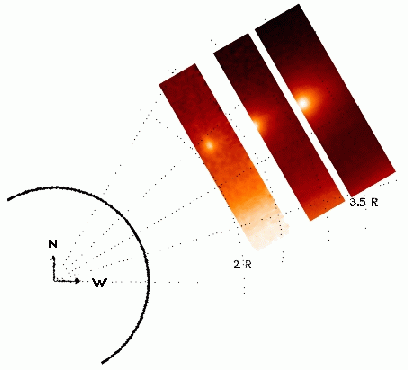
H I Lyman alpha images of this comet (C/1997 H2) combined with high resolution spectroscopy of the Lyman alpha, Lyman beta, and Lyman gamma lines:

In a run of observations at the Experiment Operation Facility Goddard Space Flight Center (NASA), US, the Ultraviolet Coronagraph Spectrometer UVCS has observed the passage close to the Sun of a newly discovered comet (SOHO-8 / STETZELBERGER) on the 1st and 2nd of May, 1997.
The team performing the observation was formed by Ester Antonucci (lead scientist), Silvano Fineschi (instrument scientist), Silvio Giordano, Carlo Benna, Alberto Cora, Ray O'Neal, Rai Wu.
The comet SOHO-8 was followed by UVCS in its path toward the Sun along a direction inclined of 30 degrees with respect to the equator, coming from the North - West limb. Observations were performed, starting at 22.05 UT, May 1, from a distance of 3.2 to 2 solar radii out of the solar limb. At distances from the Sun shorter than 2 solar radii the comet became indistinguishable from the solar corona, which was erupting at that time.
After Sun-crossing it became visible again on May 2nd, when emerging from an intense coronal streamer at 13 degrees South of the equator on the East limb and it was followed with UVCS from 5.4 to 8.2 solar radii, until 01:08 UT, May 3 1997. The comet velocity along the portion of trajectory observed with UVCS was of order 100 km/sec.
The comet was imaged in the H I Lyman alpha emission at 1216 A, six times. The H I Lyman alpha line was well observed spectroscopically at high resolution (0.2 Angstroms). Significant emission in the H Lyman beta line and weak emission in H I Lyman gamma were also observed in the hydrogen inner coma.
The Lyman alpha inner coma of the comet had a linear size of 0.1 solar radii (70000 km), the more diffuse emission of the coma of 0.4 solar radii (280.000 km) in the direction perpendicular to the trajectory. In the first observation the coma is more than 0.5 solar radii (350.000 km) along the comet trajectory. The H Ly alpha coma changed shape along the orbit and it was symmetrical with respect to the inner coma with a size of almost 2 solar radii (1.4 million km) in the last observation just before leaving the field of view of UVCS. In the last observation the size of the H coma can be established with great accuracy due to the absence of solar coronal emission.
We believe this is the first time that high resolution (0.2 A) spectroscopic observations of H I Lyman beta and gamma emissions from a comet have been made and one of the first times that both Lyman alpha images and spectroscopy have been obtained.
UV line profiles will give information on the emission process by photon and collisional excitation of the neutral hydrogen, and velocity fields. As a first estimate we derive that velocity fields within the hydrogen coma are not greater than 30 km/sec.
 GO BACK to the User's Guide
Section 2
GO BACK to the User's Guide
Section 2